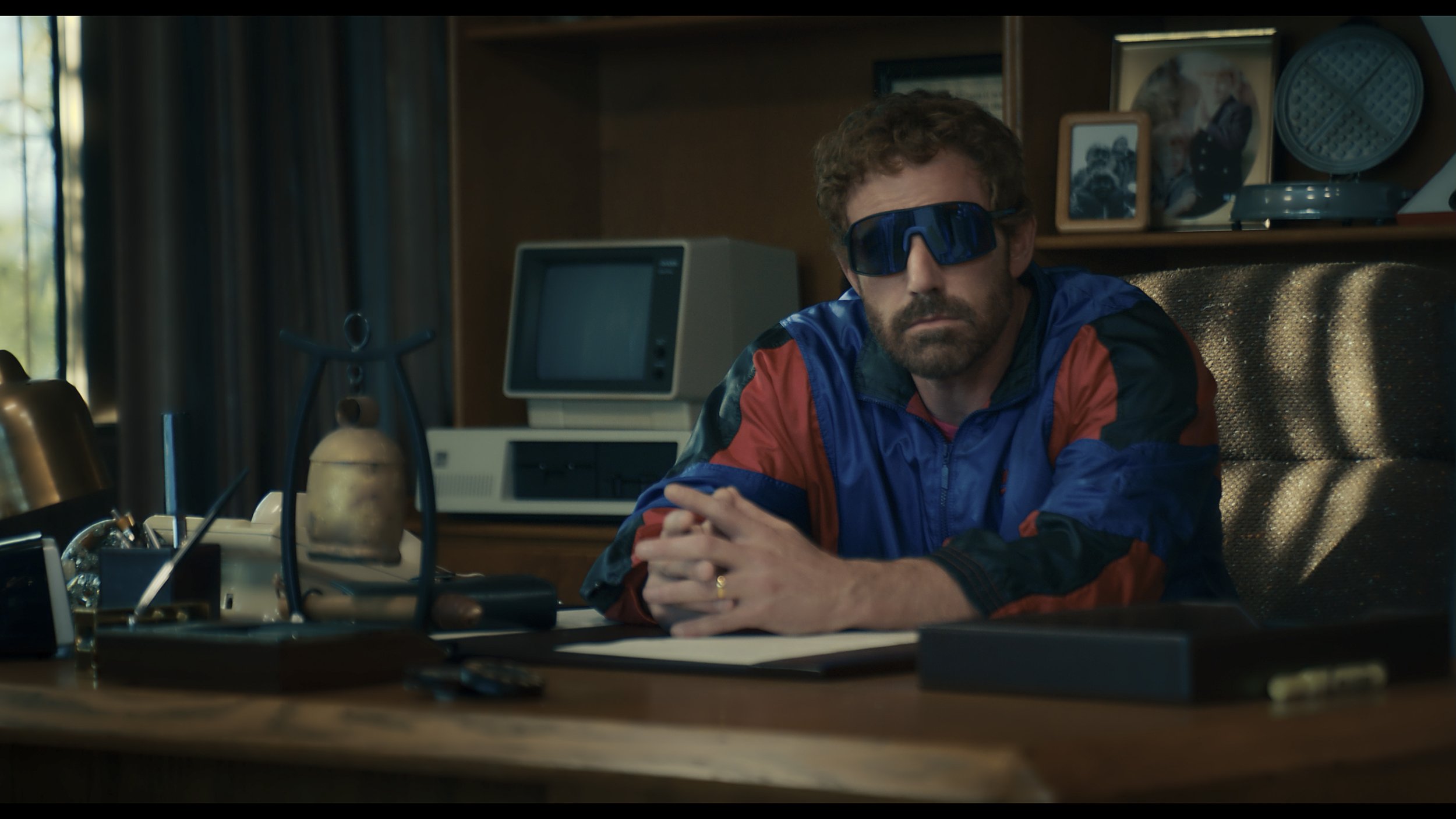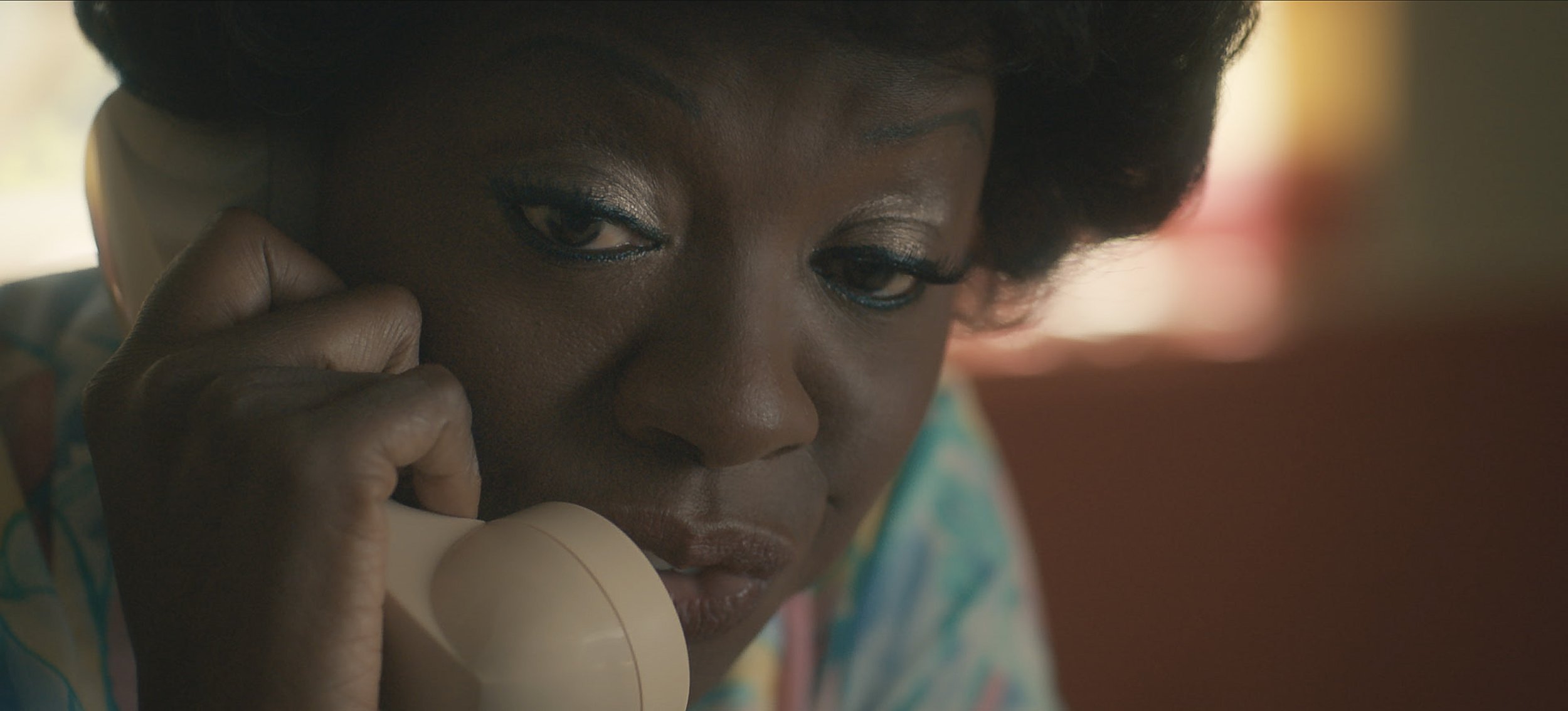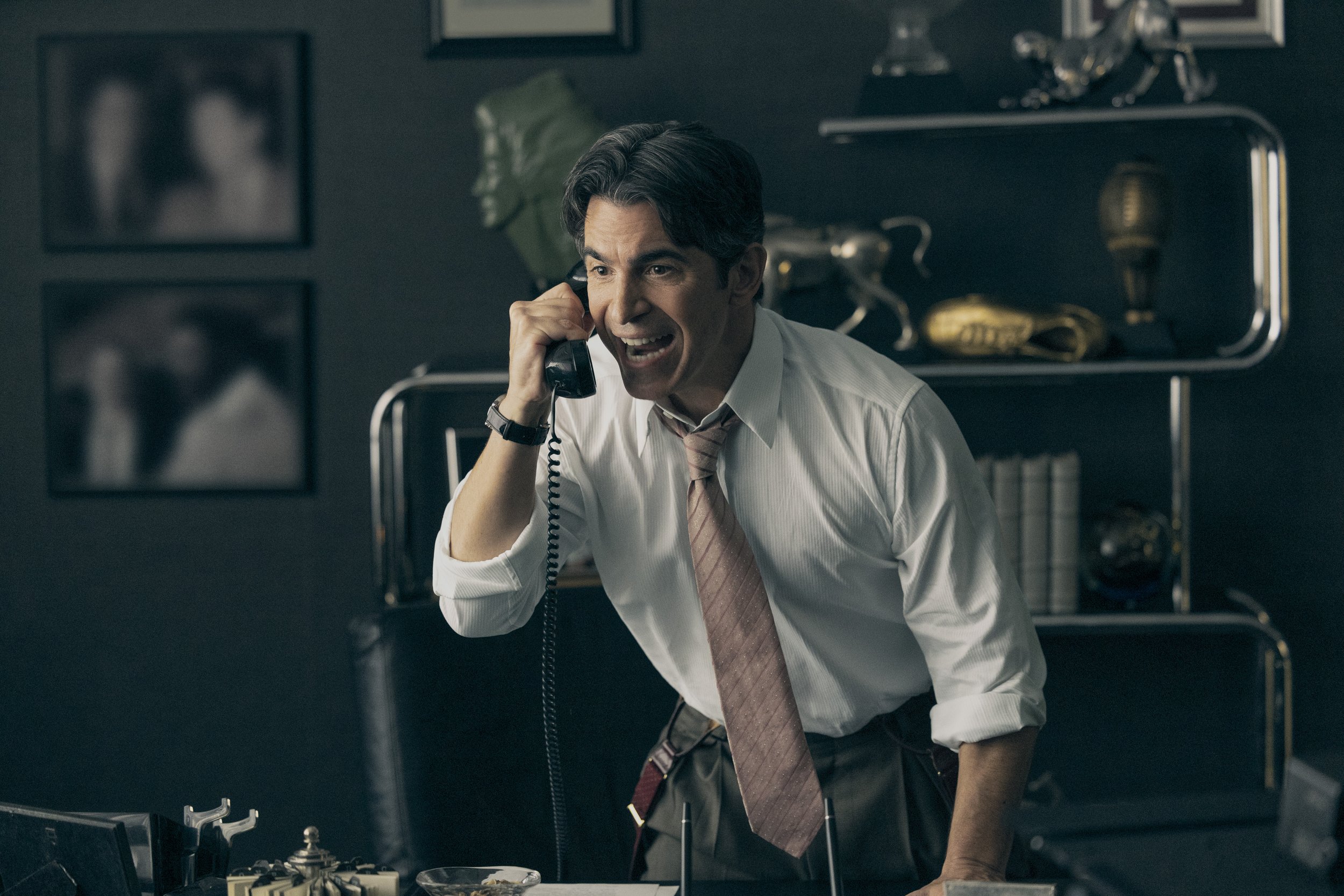Death is in the Air
Air, the story of the design and marketing of Nike’s iconic Air Jordans (image: courtesy of Amazon Studios).
1984 was the beginning of the end of the world as we know it. What the rest of the 20th century couldn’t accomplish with two world wars, the 1980s set irrevocably in motion – a collective death wish manifested through consumerism. Death by shopping if you will. And Ben Affleck’s new film Air, about the birth of Nike’s iconic shoe line, is an accidental homage to a future without a future, a symptom of the fatal disease.
I was only five years old the first time that Michael Jordan ran onto the Chicago Bull’s court wearing the now iconic Air Jordans. I was too young to wear the shoes or care much about the NBA draft pick. But before the decade was over, I definitely wanted a pair. The marketing team at Nike had found a vein of pure American desire, a golden seam deep in the psychological tunnels of the collective subconscious. The genius of the Air Jordan line lies within its marketers’ ability to grasp how we are all hardwired the same way – our little biological supercomputers clicked into the same cultural moment, reacting in similar ways to identical stimuli. Whether Black or white, poor or rich, rural or urban, American or European, we all wanted to be like Mike.
The film is directed by Ben Affleck, who also plays the co-founder of Nike, Phil Knight (image: courtesy of Amazon Studios).
I never succeeded in convincing my mom to buy me a pair of Air Jordans, and by the time I was buying my own shoes it was too late. I wish I could go back in time to give that Jordan-less child a hug and tell him that having to wear the same shitty shoes until you outgrow them is actually an ecologically responsible thing to do. Tell little Mikey that his bratty classmates and their consumerist families are collectively pulling the trigger on the climate change gun and ensuring ecological doom for future generations. Yet even today, as Air is testament to, sneaker culture is alive and well in spite of its oversized ecological impact. According to a 2018 study by Quantis, an environmental sustainability consultancy, footwear production accounts for 1.4 per cent of global carbon emissions and will increase 49 per cent by 2030. Considering that air travel comprises 2.5 per cent of all emissions, the more than $50bn athletic footwear market is a heavy hitter on the climate change contributor lineup. I nominate sneaker shaming as the new guilt-tripping activity for the activist youth of today.
Luckily for those who wish for a return to the blissful ignorance of the true American way for an hour or two, Hollywood has embraced 80s and 90s consumer culture in 2023, producing a heterogeneous crowd of films around the topic. There’s not only Air, but also the upcoming Barbie, the surprisingly entertaining Tetris, the uneventful but ultra profitable
1984 was the beginning of the end of the world as we know it. What the rest of the 20th century couldn’t accomplish with two world wars, the 1980s set irrevocably in motion – a collective death wish manifested through consumerism. Death by shopping if you will. And Ben Affleck’s new film Air, about the birth of Nike’s iconic shoe line, is an accidental homage to a future without a future, a symptom of the fatal disease.
Marlon Wayans as George Raveling, a former Olympics basketball coach (image: courtesy of Amazon Studios).
I was only five years old the first time that Michael Jordan ran onto the Chicago Bull’s court wearing the now iconic Air Jordans. I was too young to wear the shoes or care much about the NBA draft pick. But before the decade was over, I definitely wanted a pair. The marketing team at Nike had found a vein of pure American desire, a golden seam deep in the psychological tunnels of the collective subconscious. The genius of the Air Jordan line lies within its marketers’ ability to grasp how we are all hardwired the same way – our little biological supercomputers clicked into the same cultural moment, reacting in similar ways to identical stimuli. Whether Black or white, poor or rich, rural or urban, American or European, we all wanted to be like Mike.
I never succeeded in convincing my mom to buy me a pair of Air Jordans, and by the time I was buying my own shoes it was too late. I wish I could go back in time to give that Jordan-less child a hug and tell him that having to wear the same shitty shoes until you outgrow them is actually an ecologically responsible thing to do. Tell little Mikey that his bratty classmates and their consumerist families are collectively pulling the trigger on the climate change gun and ensuring ecological doom for future generations. Yet even today, as Air is testament to, sneaker culture is alive and well in spite of its oversized ecological impact. According to a 2018 study by Quantis, an environmental sustainability consultancy, footwear production accounts for 1.4 per cent of global carbon emissions and will increase 49 per cent by 2030. Considering that air travel comprises 2.5 per cent of all emissions, the more than $50bn athletic footwear market is a heavy hitter on the climate change contributor lineup. I nominate sneaker shaming as the new guilt-tripping activity for the activist youth of today.
Chris Tucker as Howard White, a Nike executive (image: courtesy of Amazon Studios).
Luckily for those who wish for a return to the blissful ignorance of the true American way for an hour or two, Hollywood has embraced 80s and 90s consumer culture in 2023, producing a heterogeneous crowd of films around the topic. There’s not only Air, but also the upcoming Barbie, the surprisingly entertaining Tetris, the uneventful but ultra profitable The Super Mario Bros. Movie (over $1bn at the box office), and even a hit indy film about the Blackberry called BlackBerry. The official trailer of the Greta Gerwig directed Barbie leaves little room for doubt that the film treats the 90s and the Barbie-associated toxic tropes with adequate distaste and irony. The quality of writing – the script has been co-written with Gerwig’s partner and longtime collaborator Noah Baumbach (Francis Ha, The Squid and the Whale, Marriage Story) – can be counted on to weave sufficient satire into the era’s consumeristic positivism. “This is the best day ever,” says one Barbie during a dance party. “I know it is! And so was yesterday and so is tomorrow, and every day from now until forever,” says another. Followed by, “Have you ever thought about dying?” It will definitely be a fun and existentially engaging movie, but that doesn’t get us any closer to understanding the sudden and intriguing attraction to 80s/90s vintage corporation-inspired filmmaking.
If there’s promise in the Barbie premise, one cannot be so kind to Air. It has been released into the wild with all of its naked flaws exposed against the projector’s bright light. “Orwell was right, 1984 is a tough year,” says Nike’s VP of Marketing Rob Strasser, played by Jason Bateman, in one of the films early scenes. But you and I know, and everyone who sits down to watch the film knows, Nike ends up signing Michael Jordan that year to create the Air Jordan line. Affleck and his regular collaborator Matt Damon, who both stars in and produced Air, were tasked with making that proposition entertaining and interesting, spending more than $70m trying to do so.
It has been just over 25 years since the early Affleck-Damon cinematographic bromances of Good Will Hunting and Chasing Amy. The quarter century in Hollywood has not fostered better cinematography in the creative couple. Chasing Amy, directed by Kevin Smith, was an independent breakthrough film heavy on good writing and light on budget – made for a mere $250,000, it grossed over $12m at the box office. And Good Will Hunting, a true gem directed by Gus Van Sant and co-written by Affleck and Damon, was a huge hit with critics and in the cinemas ($225m), earning the duo an Oscar for best screenplay, all while being made on a $10m budget. Both of these early films had the advantage of small budgets, relying on acting talent and superb storytelling. Air, on the other hand, probably won’t break even and often feels like a feature-length Nike commercial by two ageing, rich, white Hollywood actors.
Matt Damon as Sonny Vaccaro, a Nike executive (image: courtesy of Amazon Studios).
I wonder who Affleck thought the audience for his film would be. I sparingly evoke the concept of “nostalgia” to begin looking for an answer. A longing to return to a better period, perhaps? Yet it’s hard to see how the 80s and 90s were better than today, unless we see 1984 as a clear inflection point, forward from which everything slowly goes to shit. From this perspective, those were better times only when compared to the collective angst of today, amplified by hyperconnectivity and information echo- chambers. The more we know today, the greater our fear of a future of extremes grows. The 80s were a time of comfortable ignorance for the American middle class, a luxury they no longer have.
In order to grasp how a film like this could ever be made, I think it’s important to look at the origin story of the script by Alex Convery. Written during lockdown and inspired by the Netflix documentary The Last Dance, about the rise of Michael Jordan and the Chicago Bulls, Convery thought that a story about the Nike company as an underdog who signs the Adidas- loving rookie, thus changing the face of sports marketing forever, would make for a compelling film. It is his first script to ever get produced and was modified by Affleck and Damon in the revision process. According to a Hollywood Reporter interview with Affleck, the original script didn’t include two of the most important Black characters involved in the deal: the Nike executive Howard White and Jordan’s mother Deloris. Affleck added these characters and their stories to the script after discussing with MJ himself, claiming to significantly change the scope of the film.
Affleck contends that only after discussing with Jordan did he understand what the film was really about, that “it isn’t about Nike,” but about the Jordans themselves. Then nothing really explains why 90 per cent of the film is set in the Nike headquarters or else following Matt Damon’s character Sonny Vaccaro, one of the company’s marketing executives. Maybe Affleck wanted to make a movie about how Jordan’s mother Deloris deftly out-negotiated three major corporations to secure a share of the profits – a truly disruptive event in the history of competitive sports. It essentially funnelled billions of dollars away from Nike to Jordan, and set an important precedent. Unfortunately for Affleck, that isn’t the film he made. Deloris’s character and the most important human drama of the story was completely omitted from the first version of the script, only to be unskilfully added during revision.
Viola Davis as Deloris Jordan, Michael Jordan’s mother (image: courtesy of Amazon Studios).
Instead of making a film that centres around the love and intelligence of a mother for a gifted son, Affleck and Damon made a film about Nike and its executives in the 1980s, casting themselves in the principle roles. Perhaps the duo saw an opportunity in reproducing “North America 1984” as a time when a couple of daring white men could really make a difference in the world – a buddy movie with corporate America substituting for the Wild West. The film glorifies risk taking, but only when the risk is potentially loosing a cushy job and perhaps a couple hundred thousand bucks for a billion-dollar corporation. The plot rides on Sonny’s obsession with choosing the right young athlete to bet on. It concludes by leveraging all of the marketing weight of a mega company to create an insanely profitable worldwide fashion phenomenon. In an important way, this could only happen in the 1980s. A unique moment in history – a confluence of Cold War driven consumer culture and raw American talent – that generated massive profits.
You have to admit that the 1980s were interesting. We were collectively on the brink of mutual nuclear annihilation and Nintendo was all the rage. The recent 80s revival film Tetris takes this seeming paradox to the next level. Unlike Air, Tetris does what it sets out to do. It tells the improbable and unknown story of the distribution wars for the famous video game. Instead of taking a promising premise and smothering it with uninspired writing like Air, it takes an unlikely premise for a film and weaves it into a wild ride across the globe and back several times over. It’s easier to tell this type of biographical thriller in the 1980s too. There’s no second-guessing flying around the world, and the tension runs high because the protagonists can’t simply drop a pin or FaceTime when it would be convenient to do so. In high comedic fashion, this point is well made when the protagonist tries to call home from Moscow to warn his wife and is told that he’ll have to wait at least eight hours because “there are very few lines that leave our great country.”
Sonny Vaccaro meets Deloris Jordan (image: courtesy of Amazon Studios).
Similarly, there are a lot of phone calls in Air. The main character, Sonny Vaccaro, even inconspicuously wears a beeper on his belt, the unsightly black box protruding over his belly. While driving to the Jordans’ home in South Carolina, he calls the office and squawks, “This car has a phone!” The VP of marketing even has a fancy phone on his desk that is contained in a luxuriously designed wood box. The rapidity of technological development since 1984 actually generates an interesting cinematographic opportunity to create historical exoticism for a younger public, while provoking nostalgia in an older one. For it truly was a time when important men had important phones that could do only one thing – make an important call. Some of the most intriguing dialogue in the film is between Jordan’s agent David Falk, played by Chris Messina, and Sonny. Yet the two only meet face to face once in the film. And the final deal between Deloris and Sonny is also made on a landline. In today’s world, there is an unrecognised desire to return to a time of less connectivity, when a phone call was an event.
Along the same vein, stories set in today’s world are getting harder to write. The hyperconnectivity of the protagonists makes it very difficult to create suspense and intrigue. Just imagine the film Stand By Me with Google Maps. Likewise, the intrigue that is difficult to muster in storytelling is also fundamentally missing in our daily lives. Like these filmmakers, a part of us would like to set our lives in the 1980s. Our attraction to 80s and 90s culture is perhaps only a healthy reflection of a time before the internet took away our freedom to be unreachable.
The photogenic fetishism of early 80s objects in Air is also an expensive way to make an uninteresting film more entertaining. Much like lavish set designs in escapist but entertaining period pieces that take place in Colonial America, Baroque France or Victorian England, the attention to detail in Air is without fault. I suspect that a million dollars alone were spent on reproducing a convenience store used in only two scenes. There are long shots of perfectly replicated items such as candy cigarettes, magazines, 35mm film, and perfect piles of white Wonder Bread. These painstakingly reproduced everyday lowbrow objects, isolated by the camera and projected onto enormous screens throughout the world, are transfigured into symbols of Reagan-era hyper-consumerism. They represent the destructive forces of extraction capitalism set long ago into motion, encased in shiny petroleum plastic wrappings of dead dinosaur carbon.
Chris Messina as David Falk, Michael Jordan’s agent (image: courtesy of Amazon Studios).
Air is also the origin story of the ultimate celebrity endorsement. By associating its brand with one of the most iconic and talented basketball players of all time, Nike leveraged Jordan’s star power and appeal to capture the attention and admiration of consumers. Michael Jordan’s athletic prowess, charisma, and cultural influence made him an ideal figure to endorse the sneakers and turn Team Jordan into a multibillion dollar empire. The profit sharing and co-design deal he made with Nike also cracked open the door for cultural icons to collaborate on the design of the objects that carry their name and to eventually create their own lines without the intermediary of large corporations.
The influence this pivotal moment in history has had on popular culture, design and power relations is great. But the film, by focusing on the Nike side of things, missed the opportunity to tell a more compelling story of how a poor Black family from South Carolina flipped the script on corporate America. That story should not be a subplot in a film about white men getting richer, but a film unto itself. Instead, Affleck’s film could act more as a divining stick, indicating the year when the collective modern death wish crystallised into the form of the perfect basketball shoe – the Air Jordan.
Words Michael David Mitchell
This article was originally published in Design Reviewed #2. To buy the issue, or subscribe to the journal, please visit the online shop.








